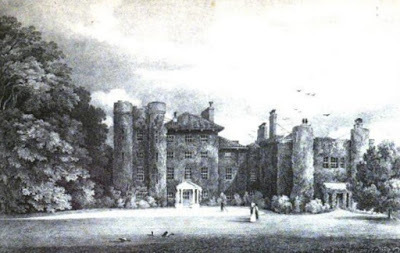Rachel Knowles's Blog, page 7
November 29, 2019
Lady Hertford - Prinny's intimate friend
 Lady Beauchamp, later 2nd Marchioness of Hertford
Lady Beauchamp, later 2nd Marchioness of Hertfordby John Hoppner (1784) from John Hoppner RA
by WD McKay and W Roberts (1909)Profile
Isabella Ingram Seymour Conway, Marchioness of Hertford (10 June 1759 – 12 April 1834), was the intimate friend and possibly mistress of the young George IV from 1807 to 1819/20.
Family
Isabella Anne Ingram was born on 10 June 1759, the daughter of Charles Ingram, 9th Viscount Irvine (1727-1778), and his wife, Frances Shepheard (1733-1807). She had a younger sister...
Published on November 29, 2019 06:38
November 15, 2019
Edward Smith Stanley, 12th Earl of Derby, after whom the Epsom Derby is named
 Edward Smith Stanley, 12th Earl of Derby, by George Keating
Edward Smith Stanley, 12th Earl of Derby, by George Keatingpublished by William Austin, after Thomas Gainsborough
mezzotint, published 20 May 1785
© NPG D35034Profile
Edward Smith Stanley, 12th Earl of Derby (12 September 1752 – 21 October 1834) is best remembered for his passion for sport. Two of the British classic horse races still commemorate that passion – the Epsom Derby, named after him, and the Epsom Oaks, named after his hunting lodge, The...D35034
Published on November 15, 2019 04:39
October 31, 2019
The Oaks - birthplace of the Epsom Derby
 The Oaks from Select Illustrations of the County of Surrey by GF Prosser (1828)When I was a girl, I lived on Woodmansterne Road in Carshalton, Surrey (though my husband argues that it is really in London as it is part of the London Borough of Sutton). I often visited nearby Oaks Park with my brothers.
The Oaks from Select Illustrations of the County of Surrey by GF Prosser (1828)When I was a girl, I lived on Woodmansterne Road in Carshalton, Surrey (though my husband argues that it is really in London as it is part of the London Borough of Sutton). I often visited nearby Oaks Park with my brothers. Deep in the depths of the park lie the ruins of The Oaks – the villa of Edward Smith-Stanley, 12th Earl of Derby. The Earl ha...
Published on October 31, 2019 02:51
October 15, 2019
The Bachelor Duke - William Spencer Cavendish, 6th Duke of Devonshire (1790-1858)
 William Spencer Cavendish, 6th Duke of
William Spencer Cavendish, 6th Duke ofDevonshire - on Oak Stairs at Chatsworth
Photo © A Knowles (2014)Profile
William Spencer Cavendish, 6th Duke of Devonshire (21 May 1790 - 18 January 1858), was known as the Bachelor Duke, because he never married. He was a patron of the Whigs, but his absorbing passions were more cultural than political with deep interests in horticulture, literature, science and sculpture.
Birth and family
William Spencer Cavendish was born in Paris on 21 May 1790, the long-...
Published on October 15, 2019 07:37
September 30, 2019
Turnpikes and toll houses
 Toll house, Blists Hill Victorian Town, Ironbridge © A Knowles (2018)What was a turnpike road?
Toll house, Blists Hill Victorian Town, Ironbridge © A Knowles (2018)What was a turnpike road?A turnpike road was a toll road operated under a trust set up by an Act of Parliament. A Turnpike Act authorised a group of trustees to levy tolls on a stretch of road in order to finance its maintenance and improvement. The toll rates were set by the Act which also empowered the trustees to borrow money secured on future tolls in order to invest in road improvements. Money could be borrowed by bonds...
Published on September 30, 2019 08:28
September 12, 2019
The Gordon Riots of 1780
 The Gordon Riots
The Gordon Riotsfrom The Chronicles of Crime or The Newgate
Calendar by C Pelham illustrated by Phiz (1841)For a week in June 1780, London experienced some of the worst riots that the city has ever seen. Thousands of anti-Catholic protestors gathered to petition Parliament, but what began as a peaceable religious protest turned into a destructive riot, causing havoc across the city.
The Gordon Riots play a small but important part in A Perfect Match. The hero, Christopher Merry, has never...
Published on September 12, 2019 02:16
August 12, 2019
How to find Ackermann's Repository of Arts online
 Front cover of Ackermann's Repository
Front cover of Ackermann's RepositoryVolume 5 (1811)Ackermann’s Repository of Arts, Literature, Commerce, Manufactures, Fashions, and Politics was a monthly periodical that was published from 1809 to 1828. You can read more about Ackermann’s Repository of Arts here.
There are copies of Ackermann's Repository available online, but it is not always easy to find them. Here is my list of links:
Jan - Jun 1809 - Series 1 Volume 1
Jul - Dec 1809 - Series 1 Volume 2
Jan - Jun 1810 - Series 1 Volume 3
Ju...
Published on August 12, 2019 09:16
July 28, 2019
Theatre Royal, Bury St Edmunds - a Regency playhouse
 The auditorium of the Theatre Royal, Bury St EdmundsOn our way back from holiday in Norfolk, my husband Andrew and I managed to squeeze in a tour of the Theatre Royal, Bury St Edmunds – the only surviving Regency theatre in England. I was interested to see inside this restored Grade I listed playhouse to get an idea of what a provincial theatre in late Georgian England, like the one that once existed on Weymouth seafront, would have looked like.
The auditorium of the Theatre Royal, Bury St EdmundsOn our way back from holiday in Norfolk, my husband Andrew and I managed to squeeze in a tour of the Theatre Royal, Bury St Edmunds – the only surviving Regency theatre in England. I was interested to see inside this restored Grade I listed playhouse to get an idea of what a provincial theatre in late Georgian England, like the one that once existed on Weymouth seafront, would have looked like. William Wilkins (1778-1839)
 Bust of William Wilk...
Bust of William Wilk...
Published on July 28, 2019 08:28
July 16, 2019
Curricles, gigs and phaetons in the Regency
 Ladies in a phaeton from Gallery of Fashion
Ladies in a phaeton from Gallery of Fashionby Nikolaus von Heideloff (1794)It is impossible to write a novel set in the late Georgian and Regency periods without knowing something about carriages. Otherwise you might send your hero driving around Hyde Park in the Georgian equivalent to a Ford Galaxy when you really meant him to be driving a Ferrari!
I have already blogged about travelling chariots here: Travelling chariots. This post looks at that all-important question: what type of carriage...
Published on July 16, 2019 13:48
June 27, 2019
Adam Style and the work of Robert Adam
 Saloon, Saltram © A Knowles 2014Robert Adam (1728-1792) was an influential Neoclassical architect. Having trained under his father William, the leading Scottish architect of his time, and been in partnership with his elder brother John, Robert established his own architectural practice in London after coming back from his Grand Tour in 1757. He took his younger brother James (1732-1794) into partnership with him in 1763.
Saloon, Saltram © A Knowles 2014Robert Adam (1728-1792) was an influential Neoclassical architect. Having trained under his father William, the leading Scottish architect of his time, and been in partnership with his elder brother John, Robert established his own architectural practice in London after coming back from his Grand Tour in 1757. He took his younger brother James (1732-1794) into partnership with him in 1763. You can read more about the life of Robert Adam here.
 Wedgwood cameo of R...
Wedgwood cameo of R...
Published on June 27, 2019 08:47



